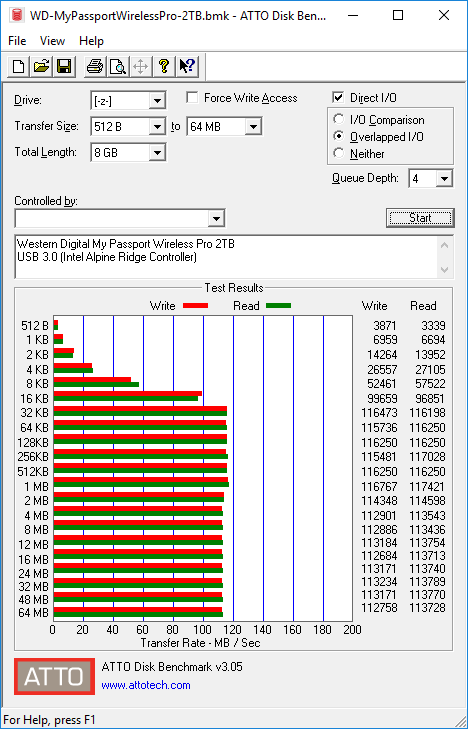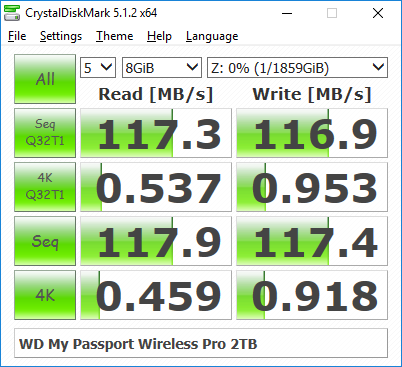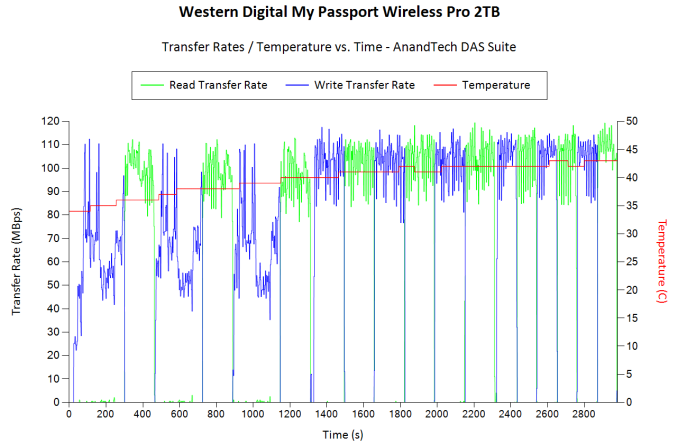Western Digital My Passport Wireless Pro Wi-Fi Hard Drive Review
by Ganesh T S on June 21, 2016 8:08 AM EST- Posted in
- Storage
- Western Digital
- Gadgets
- wireless storage
DAS Benchmarks
The primary purpose of the My Passport Wireless Pro device is to act as a storage extension for mobile devices. Connecting the device to a 'Home Network' SSID also exposes up to three folders as CIFS shares, Storage, SD and USB. The availability of the last two are dependent on the presence of a SD card and/or USB drive. Data can be transferred between a PC and the device via these CIFS shares. That said, the My Passport Wireless Pro also doubles up as a high-speed portable hard drive (with support for WD's custom utilities such as WD Backup). The internal disk is pre-formatted in exFAT in order to be compatible with multiple operating systems. Transfer of large-sized media collections / libraries and periodic computer backups are best done through the USB 3.0 interface and not via Wi-Fi. In order to evaluate this aspect of the My Passport Wireless Pro, we utilized the testbed outlined in the table below to test the DAS performance. The USB 3.1 Gen 2 port enabled by the Intel Alpine Ridge ontroller was used to benchmark the unit..
| AnandTech DAS Testbed Configuration | |
| Motherboard | GIGABYTE Z170X-UD5 TH ATX |
| CPU | Intel Core i5-6600K |
| Memory | G.Skill Ripjaws 4 F4-2133C15-8GRR 32 GB ( 4x 8GB) DDR4-2133 @ 15-15-15-35 |
| OS Drive | Samsung SM951 MZVPV256 NVMe 256 GB |
| SATA Devices | Corsair Neutron XT SSD 480 GB Intel SSD 730 Series 480 GB |
| Add-on Card | None |
| Chassis | Cooler Master HAF XB EVO |
| PSU | Cooler Master V750 750 W |
| OS | Windows 10 Pro x64 |
| Thanks to Cooler Master, GIGABYTE, G.Skill and Intel for the build components | |
Our testing methodology for DAS units takes into consideration the usual use-case for such devices. The most common usage scenario is transfer of large amounts of photos and videos to and from the unit. The other usage scenario is importing files directly off the DAS into a multimedia editing program such as Adobe Photoshop. Prior to taking a look at the real-life benchmarks, we first check what ATTO and CrystalDiskMark have to report for the My Passport Wireless Pro. We see steady numbers around 110 MBps for sequential transfers, correlating well with WD's performance claims.
In order to tackle the first real-life use-case, we created three test folders with the following characteristics:
- Photos: 15.6 GB collection of 4320 photos (RAW as well as JPEGs) in 61 sub-folders
- Videos: 16.1 GB collection of 244 videos (MP4 as well as MOVs) in 6 sub-folders
- BR: 10.7 GB Blu-ray folder structure of the IDT Benchmark Blu-ray (the same that we use in our robocopy tests for NAS systems)
| Western Digital My Passport Wireless Pro 2TB robocopy Benchmarks (MBps) | ||
| Write Bandwidth | Read Bandwidth | |
| Photos | 62.36 | 97.66 |
| Videos | 100.06 | 101.98 |
| Blu-ray Folder | 99.75 | 104.13 |
For the second use-case, we take advantage of PC Mark 8's storage bench. The storage workload involves games as well as multimedia editing applications. The command line version allows us to cherry-pick storage traces to run on a target drive. We chose the following traces.
- Adobe Photoshop (Light)
- Adobe Photoshop (Heavy)
- Adobe After Effects
- Adobe Illustrator
Usually, PC Mark 8 reports time to complete the trace, but the detailed log report has the read and write bandwidth figures which we present in our performance graphs. Note that the bandwidth number reported in the results don't involve idle time compression.
| Western Digital My Passport Wireless Pro 2TB PCMark8 Storage Benchmarks (MBps) | ||
| Write Bandwidth | Read Bandwidth | |
| Adobe Photoshop (Light) | 157.68 | 2.45 |
| Adobe Photoshop (Heavy) | 124.21 | 3.46 |
| Adobe After Effects | 79.19 | 2.59 |
| Adobe Illustrator | 97.34 | 2.50 |
The robocopy benchmarks were instrumented for performance consistency purposes. Instantaneous transfer rates and drive temperature were recorded.
The drive doesn't go beyond 45C even after ore than 250GB of continuous transfers. There is no thermal throttling or overheating in the system under heavy loading conditions.













25 Comments
View All Comments
Impulses - Wednesday, June 22, 2016 - link
There ARE portable mini routers (sized like a pack of cards or smaller) with very similar functionality (card reader, battery, hotspot, etc) and a USB port unto which you can hook up any portable drive.marvdmartian - Thursday, June 23, 2016 - link
That's true. But for travel purposes, I'd rather have it all in one unit. Drop a hdd or ssd in there, and you're good to go, AND it's taking up less space in the carry-on bag. Space and weight are a premium, these days, if you're flying.mr_tawan - Sunday, June 26, 2016 - link
I saw some Chinese-made system with OpenWRT. Haven't tried but I expected to be better than WD :).Huppie76 - Thursday, July 21, 2016 - link
Hi. Is possible to putt a ssd into this device? How did you open it? Is it hard to open it?Tenx for the good review
windz - Wednesday, June 22, 2016 - link
Having the Plex media server in a portable Wi-Fi drive is bad ass. Finally I can stream all my MKV to my iPad Pro on the road.ravedog - Friday, June 24, 2016 - link
I don't think you mkvs will work in the iPad. The unit does not do any transcoding only straight thru playing. So the device doing the playback has to support mkv which I'm fault certain the iPad might not. (Unless there was a way to pipe the files into Vlc or infuse.)HanaAndHerSistersTech - Thursday, June 23, 2016 - link
Pass. Had two WD external USB drives die out in past six months, they were only a year old. Going to HGST now.Phynaz - Friday, June 24, 2016 - link
This thing will operate as a Plex media server, right? Why wasn't that aspect reviewed?wossman - Saturday, June 25, 2016 - link
I had the 2014 2TB model (before I accidentally dropped in onto my toes from about 2.5 feet and it never worked again) and the thing that frustrated me most about using it in DAS mode (which I did most often) was how quickly the drive would spin down. It seems like it would sleep after as little as 2 minutes of inactivity or less. And it took its own sweet time spinning up again, during which time most Windows 8.1 systems would lock up the UI of the app trying to access the drive.I searched high and low for a utility that would let me change the sleep timer of the drive but I never found one. Otherwise, the drive was fine. I'd only try this new version if I know that issue's been fixed or someone can recommend a way of changing the timer to something I prefer. I'm fine with the drop in battery life that would come with the change.
mr_tawan - Sunday, June 26, 2016 - link
I think they are Green drives, so that's normal. I think WD Green are re-branded as Blue now though.